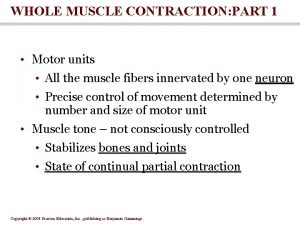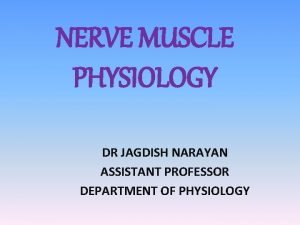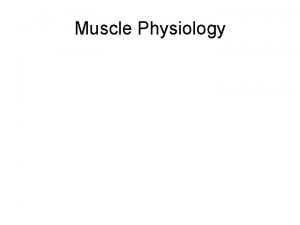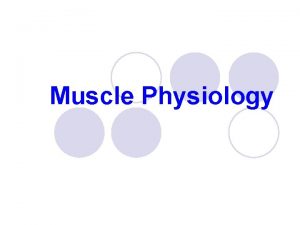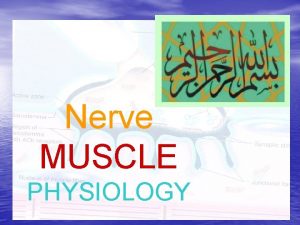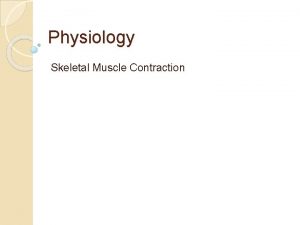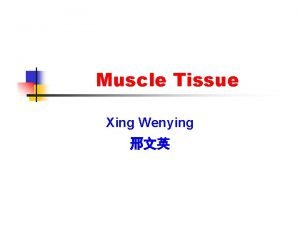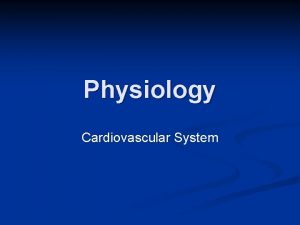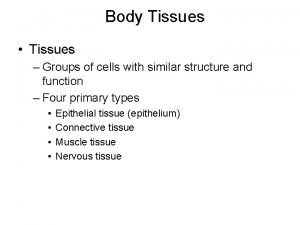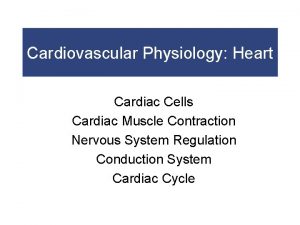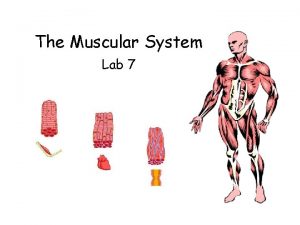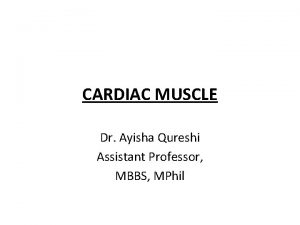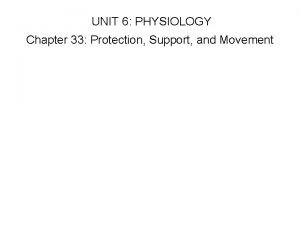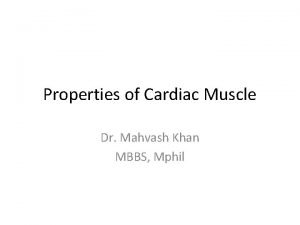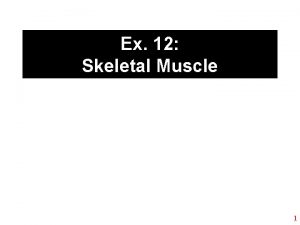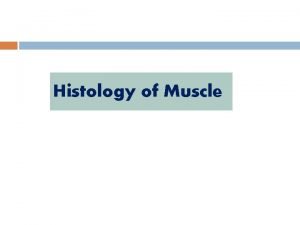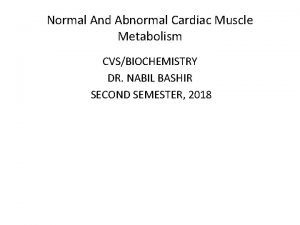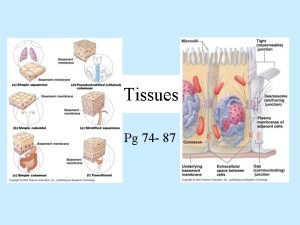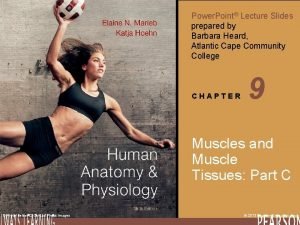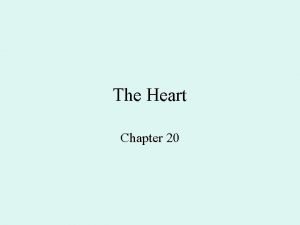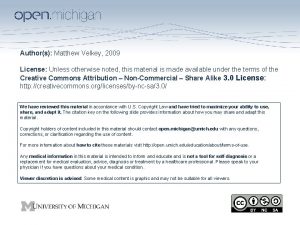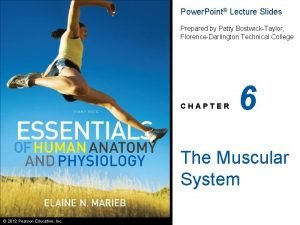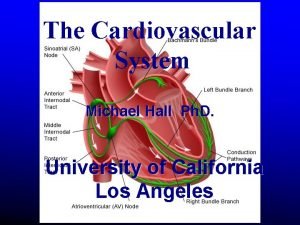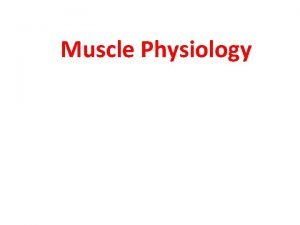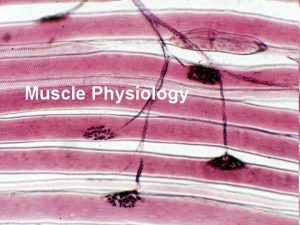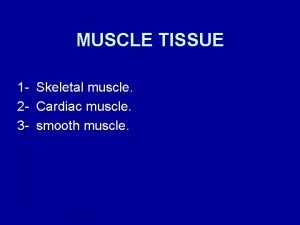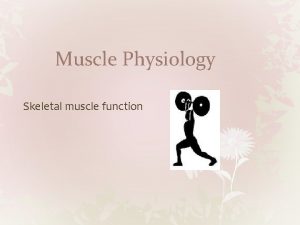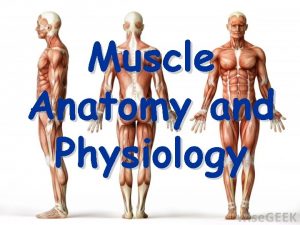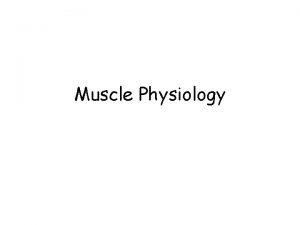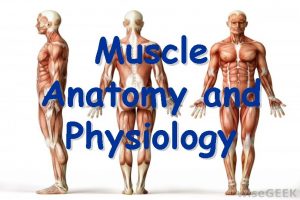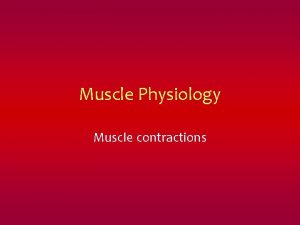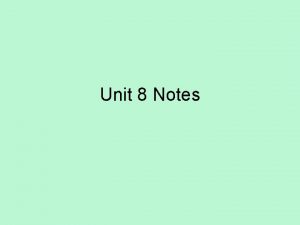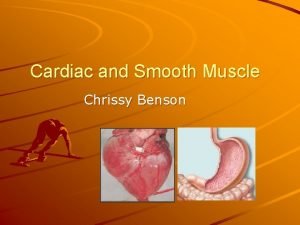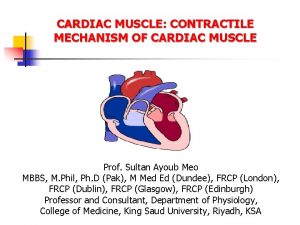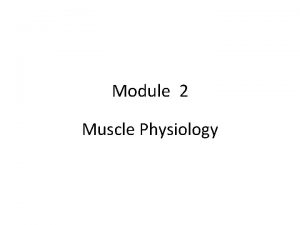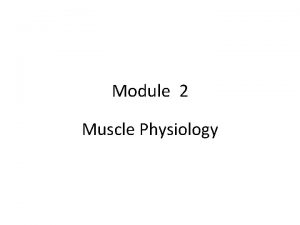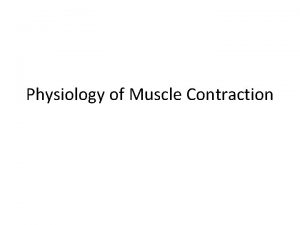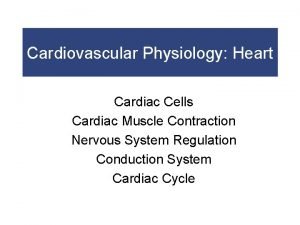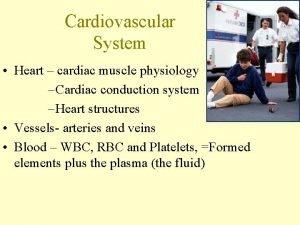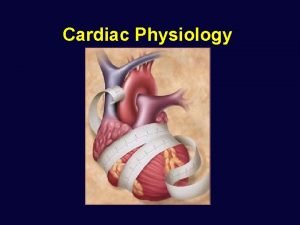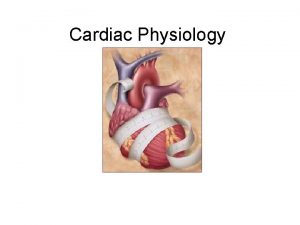PHYSIOLOGY 1 LECTURE 24 CARDIAC MUSCLE MECHANICS CARDIAC
























- Slides: 24

PHYSIOLOGY 1 LECTURE 24 CARDIAC MUSCLE MECHANICS

CARDIAC MUSCLE MECHANICS n Cardiac Muscle is unique in several aspects from both skeletal and smooth muscle. First of all cardiac muscle operates on the left hand ascending limb of the active tension curve so that stretching cardiac myocytes results in increased force of contraction (Frank-Starling law of the heart). Second due to the low concentration of Ca++ ion muscle contraction can be enhanced in both strength and speed by increased Ca++ influx (Contractility or Inotrophy).

CARDIAC MUSCLE MECHANICS The isometric and isotonic condition n Cardiac muscle goes through the same series of isometric and isotonic events as skeletal muscle. Therefore, the cardiac cycle (Heart beat) has two phases which are considered to isometric (Isovolumic contraction, and Isovolumic relaxation) while all the other phases are considered to be isotonic in nature.

CARDIAC MUSCLE MECHANICS The isometric and isotonic condition n Active tension curve- Due to the heavy amounts of connective tissue the heart’s sarcomere length is shorter than that of skeletal muscle (1. 6 mm vrs. 2. 2 mm). This means that the heart operates on the left hand ascending limb of it’s active tension curve. Note - There is no right hand descending limb to the cardiac tension curve for this reason.

CARDIAC MUSCLE MECHANICS Review of Skeletal muscle Tension n In skeletal muscle the length tension relationship is controlled by the split into the contractile element (active tension) plus the series and parallel elastic elements (passive tension) which equals to total tension.

CARDIAC MUSCLE MECHANICS Cardiac muscle Length-Tension n In cardiac muscle the resting sarcomere length is 1. 6 mm due to the large amount of connective tissue. This places the resting sarcomere length on the left hand ascending limb of the active tension curve.

CARDIAC MUSCLE MECHANICS Cardiac muscle Length-Tension n The passive tension curve in cardiac muscle begins with the active tension curve and increases rapidly eliminating the right hand descending limb of the active tension curve.

CARDIAC MUSCLE MECHANICS Cardiac muscle Length-Tension n The cardiac muscle total tension curve then is nearly a straight line steadily increasing. This means that stretching the cardiac muscle sarcomeres results in an increased force and speed of contraction (Frank-Starling law of the heart.

CARDIAC MUSCLE MECHANICS Cardiac muscle Length-Tension n n Frank-Starling Law of the Heart The heart pumps whatever is presented to it (Venous return). Stretch of the cardiac sarcomeres causes an increase in force and speed of contraction.

CARDIAC MUSCLE MECHANICS Cardiac Load-Velocity Relationship n There are two types of load cardiac muscle is presented with. First is afterload or the load the heart must pump against in this case it is aortic artery pressure or pulmonary artery pressure. In order for the semilunar valves to open the ventricles of the heart must generate greater pressures than the afterload. In the second case the heart must move blood or preload, we will be calling this venous return.

CARDIAC MUSCLE MECHANICS Cardiac Load-Velocity Relationship n The isotonic condition -

CARDIAC MUSCLE MECHANICS Cardiac Load-Velocity Relationship B. Affect of changing afterload (Aortic Pressure or Diastolic Pressure) constant preload n The pressure in the left ventricle must exceed aortic pressure in order to open the aortic semilunar valve. Therefore, as aortic pressure rises, such as in hypertension, then the heart must work harder to overcome the afterload. n

CARDIAC MUSCLE MECHANICS Cardiac Load-Velocity Relationship n In general the cardiac muscle load to velocity of shortening curve is similar to the skeletal muscle curve.

CARDIAC MUSCLE MECHANICS Cardiac Load-Velocity Relationship n As afterload on the heart increases the velocity of shortening decreases.

CARDIAC MUSCLE MECHANICS Cardiac Load-Velocity Relationship C. Affect of changing preload - constant afterload n Preload on the heart is the venous return. As venous return increases stretching the sarcomeres, which in turn by Frank-Starling the heart increases force of contraction. In effect this shifts the velocity of shortening to load curve to the right increasing the speed of n

CARDIAC MUSCLE MECHANICS Cardiac Load-Velocity Relationship n As preload is increased the velocity of shortening to load curve is shifted to the right. Frank. Starling Law of the heart. Hence, increased velocity of contraction for any given load.

CARDIAC MUSCLE MECHANICS Cardiac Contractility n D. Concept of contractility or inotrophy n Contractility or inotrophy is an increase in cytosolic calcium concentration. This phenomenon is under the control of the sympathetic nervous system. As NE is released it activates both the b 1 and a 1 receptors which activate both c. AMP and IP 3 second messengers which cause phosphorylation of calcium channels and thus, increased Ca++ influx. Therefore, more Troponin is activated - > force & Vel.

CARDIAC MUSCLE MECHANICS Cardiac Load-Velocity Relationship n n Concept of Contractility The heart can also increase both the force and velocity of contraction by increasing it’s efficiency through sympathetic stimulation. (catacholamines)

CARDIAC MUSCLE MECHANICS Cardiac Load-Velocity Relationship n An increase in sympathetic stimulation of the heart increases cytosolic Ca++ ion concentration thereby, increasing both the force and velocity of shorting of cardiac muscle. This makes the heart more efficient and increases performance, but also increases cardiac work.

CARDIAC MUSCLE MECHANICS Cardiac Pressure-Volume Loops n Pressure volume loops are an excellent way of illustrating cardiac performance through out the cardiac cycle. They can be used to illustrate contractility, afterload, and preload effects on cardiac performance. The drawback is that they can only be utilized on one side of the heart therefore, the following discussion involves only the left ventricle but the right is similar.




 Microbial physiology notes
Microbial physiology notes Site:slidetodoc.com
Site:slidetodoc.com Nerve muscle physiology
Nerve muscle physiology Muscle physiology
Muscle physiology Incomplete tetanus muscle contraction
Incomplete tetanus muscle contraction Excitation contraction coupling
Excitation contraction coupling Epimysium tendon
Epimysium tendon Smooth mucle
Smooth mucle Properties of cardiac muscle
Properties of cardiac muscle Connective tissue disease adalah
Connective tissue disease adalah Membrane potential of cardiac muscle
Membrane potential of cardiac muscle Cardiac muscle cell vs skeletal
Cardiac muscle cell vs skeletal Cardiac muscle
Cardiac muscle Cardiac muscle tissue
Cardiac muscle tissue Cardiac muscle mitochondria
Cardiac muscle mitochondria All or none law
All or none law Brachioradialis posterior view
Brachioradialis posterior view Characteristics of skeletal smooth and cardiac muscle
Characteristics of skeletal smooth and cardiac muscle Glycolysis in cardiac muscle
Glycolysis in cardiac muscle Cardiac muscle tissue parts
Cardiac muscle tissue parts Slide
Slide Stroke volume
Stroke volume Spleen histology slide labeled
Spleen histology slide labeled Characteristics of skeletal smooth and cardiac muscle
Characteristics of skeletal smooth and cardiac muscle Cardiac muscle
Cardiac muscle

